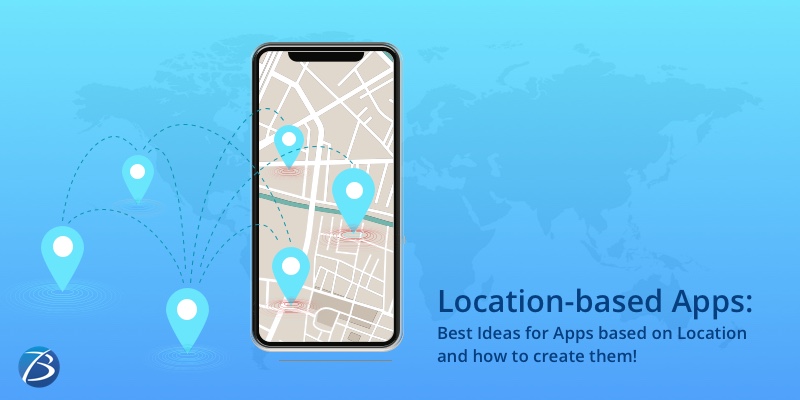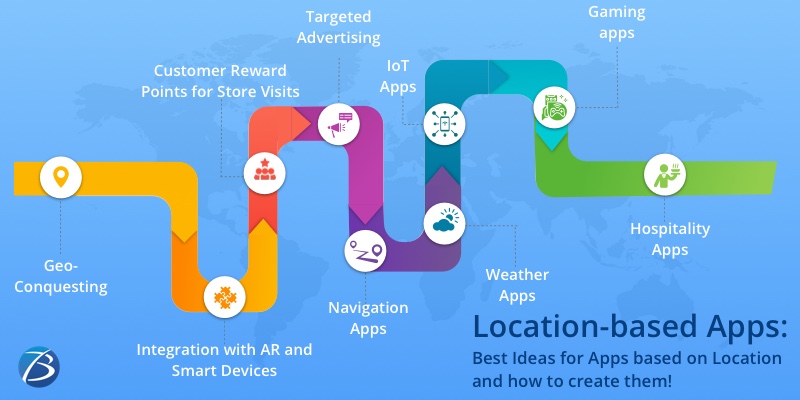
The power of location-based service apps is rising at a fast pace! Here are some instances!
- The user books a cab and it arrives exactly at their current location even if the address was not entered.
- The user is looking for a dine-in space and a location-based app on their smartphone displays eatery recommendations within close proximity.
- The user receives weather forecasts as well as the latest updates about it.
- Users receive assistance in maintaining safety during a natural disaster or some other emergency.
To sum up, location-based apps not only enable businesses to provide services as per the consumers’ immediate location but also help users in locating a nearby service, place, or person. For, this reason, most of the modern-era applications have embedded the geolocation technology regardless of whether the app user utilizes or ignores it.
This post provides insights on the use cases of location-based apps, suggests some handy app development ideas, and guides through developing an impeccable location-based application.
Location-based apps: Functioning
The location-based service technology uses real-time geodata from smartphones to instantly track the users’ current location and then provide information, advice, or guidance concerning the desired services/sites. Geolocation technologies that broadcast the location information for location-based apps are Wi-Fi, GPS (Global Positioning System), satellite signals, signal strength indication, cell id tower info, etc.
Location-based Apps: Use Cases

Navigation Apps
Apps like Google Maps, Maps.me, and Maze are popular outdoor navigational mapping applications that help travelers to find the best routes and offer step-by-step guidance to reach a location. Maps.me goes one step ahead as it works offline as well.
Amongst the indoor navigational apps; the Purple app assists patients to navigate within the Allina Health Hospital and Sarasota Memorial Hospital while Mapsted helps visitors navigate through huge malls.
Food Delivery, On-demand and Retail Apps
Food delivery apps like Uber Eats, Zomato, Glovo, and GrubHub employ geolocation technology to facilitate effective navigation for delivery staff and allow real-time order tracking by customers.
Uber is one of the shining stars in the on-demand category and has revolutionized the taxi booking experience altogether. This app automatically tracks the users’ current pickup location and sends the cab driver to the venue accordingly. Users are also able to track the drivers’ movement before the cab’s arrival as well as during their ride.
Retail apps such as IKEA, Target, Walmart utilize this concept to boost the customer experience. GPS is employed to help consumers find the nearest store, select a convenient delivery/pickup location, etc. and Beacons are used for providing in-store navigation.
Location tracking apps
Most Android and iOS devices possess built-in location tracking features so that owners can easily locate their devices when stolen or lost. However, for activating this function, the devices’ GPS feature needs to be turned on.
Geolocation tracking also helps in detecting suspicious activity thereby protecting the users’ data. For instance, Gmail users receive a security alert when they try to log into their account from a different country.
Parents are able to track their child’s whereabouts in real-time using the FootPrints app.
Support Groups and Sponsor Finder, a location-based messaging app, help disabled individuals or the ones with addiction problems to receive timely help during emergencies.
Social Networking Apps
The geolocation functionality facilitates social networking apps users to share their current location, mark it on their posts, mark themselves safe/in trouble during unforeseen situations like natural disasters or terrorist attacks, check into places, and many more.
Foursquare had coined the idea of checking into a location via smartphone devices, a concept that has been copied by several apps, including Yelp and Facebook. Foursquare’s Swarm app allows users to share their location with friends in the contact list, send invites to friends for joining them, and even enables them to locate the contacts available nearby.
Apps such as Snapchat and Instagram, too employ map view to enable geotag-empowered posts and view nearby contacts.
Dating apps, like Tinder, provide pictures of nearby users to customers and helps them to meet them as well.
Local Parties Finder proves handy to travelers searching for night activities.
IoT Apps
Apps and devices employing IoT technology like fitness trackers, and wearables like smartwatches, utilize the location-based approach for improved outcomes. Some instances of this use case include wearables paired with cycling/running apps; pet care apps that employ tags called Paw Scout, apps for family safety, and using GPS-enabled devices such as LugLoc for keeping a vigil on luggage.
Weather Apps
This is a popular category of location-based apps that provide handy information on the weather conditions along with a twenty-four-hour forecast based on the consumers’ current location. ApexWeather, Dark Sky, etc. are some notable examples.
Gaming apps
Gaming apps like Pokemon Go and Scavify leverage the geolocation technology to boost user engagement. Pokemon Go enables players to reconstruct their existing environment while Scavify deals with scavenger hunts.
Fresh New Location-based App Ideas
Geo-Conquesting
This is a novel technique that assists businesses in diverting the attention of competitors’ clients and has been implemented successfully by Dunkin Donuts. Take a look at this instance. Starbucks like most others, helps users to locate the nearest coffee shop and even enables advance ordering such that the order is ready before the users enter the store, thereby saving their time. Dunkin Donuts offers an additional feature. It sends a notification to the users who are about to enter Starbucks/or any other eatery – an ad message with a discount coupon. Isn’t it an intelligent idea to convert your competitors’ customers?
Integration with AR and Smart Devices
Location-based apps when integrated with AR can offer guided tours to travelers across the globe, with all required information flashing on the smartphone screens while moving around.
These apps when paired with smart home devices can automate tasks like automatically switch on lights when someone enters by configuring it programmatically.
Hospitality Apps
Hotel apps implementing geolocation can provide extra features – food menus; on-site navigation; self-check-in/check-out, arrival, or departure; electronic keys, etc.
Targeted Advertising
This ingenious idea is ideal for eCommerce apps and helps businesses in carrying out effective advertising campaigns. But how? Ditch the ongoing practice of conducting surveys and inviting consumers for collecting their requirements. Instead, implement geolocation to find out the customers’ daily schedule and the places frequented by them. Use this information to create a customized ad campaign for customers as per their preferences. For example, the customers who are frequent gym visitors receive ads related to products like weights, tracksuits, gym equipment, etc. whereas the ones who travel quite often receive ads concerning the purchase of travel-related stuff such as travel sacks/pillows and so on.
Customer Reward Points for Store Visits
Restaurants/food joints/cafes may utilize geolocation to identify customer visits to your space even if they miss out on opening your app during their visit and then automatically load reward points to consumers’ accounts for each visit. This move will work wonders to improve customer loyalty.
Location-based App Development Steps
Want to develop a High-end Location-based app for your business? Well, check out these basic steps on how to go ahead with the development:
- Conduct extensive research to identify the market demand for location-based service apps, explore opportunities, and analyze competitors’ strategies.
- Pick the right approach and features – The app should have a robust backend, an interactive UI, and specific functionalities like map integration (Apple/Google/Bind), GPS-co-ordination, location detection (automatically acquiring users’ present location as well as providing nearby options), and advanced route search including personalized driving directions.
- Choose the apt location tracking technology – GPS, Beacons, cellular networks, Wi-Fi, etc.
- Ensure the safety of self-portrait location data and keep your location-based app highly encrypted.
- Hire professional and experienced developers for executing your project.
- Build a location-based prototype sphere, choose a suitable app design, develop, thoroughly test the app through various stages, and then deploy.
Concluding Words:
So, isn’t it a brilliant idea to establish your digital footprints by architecting a unique location-based application? In case of any queries or technical assistance concerning app ideation as well as creation, reach out to Biz4Solutions, a highly experienced Offshore mobile app Development Company in India, catering to global clients across myriad industrial domains.
